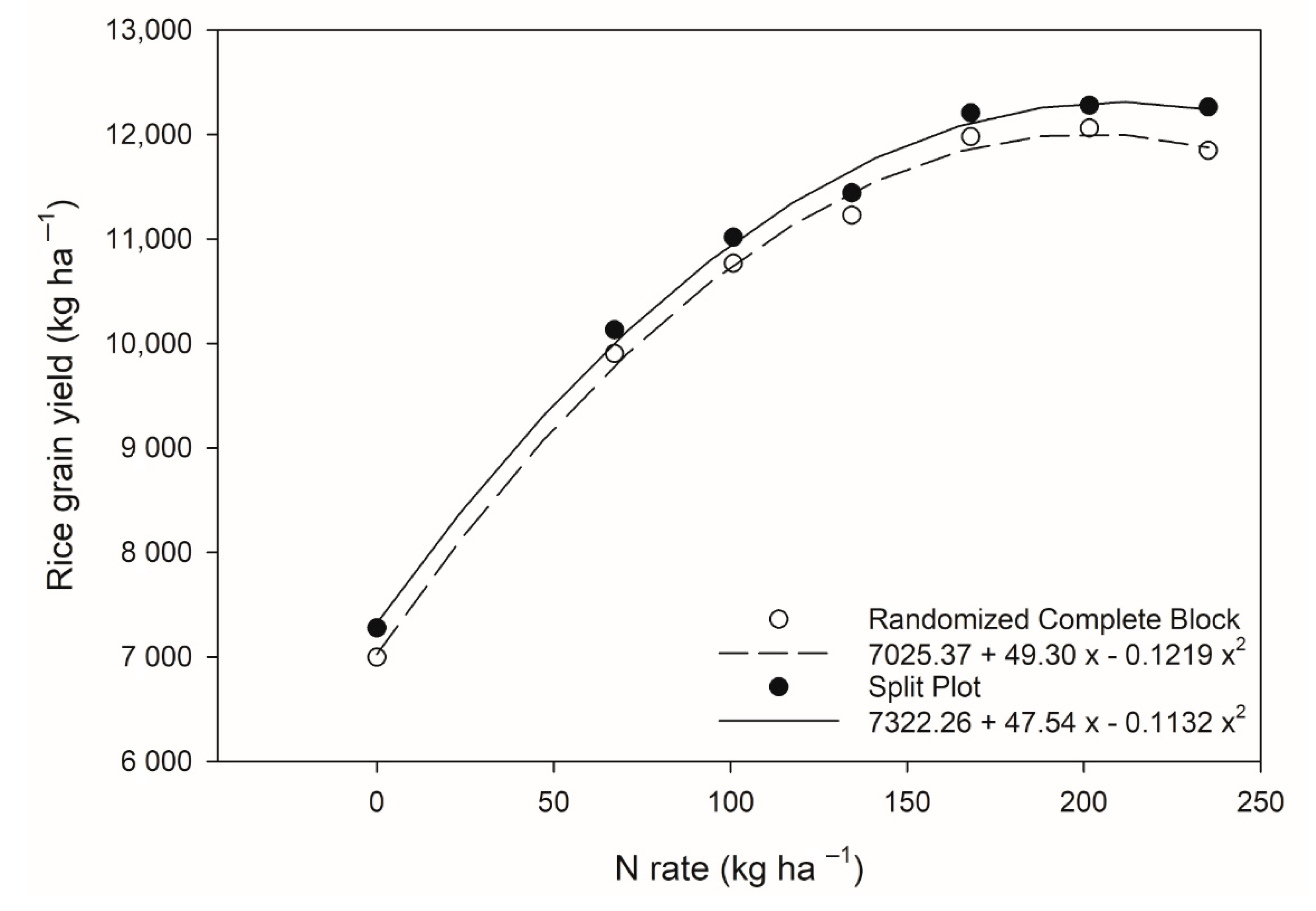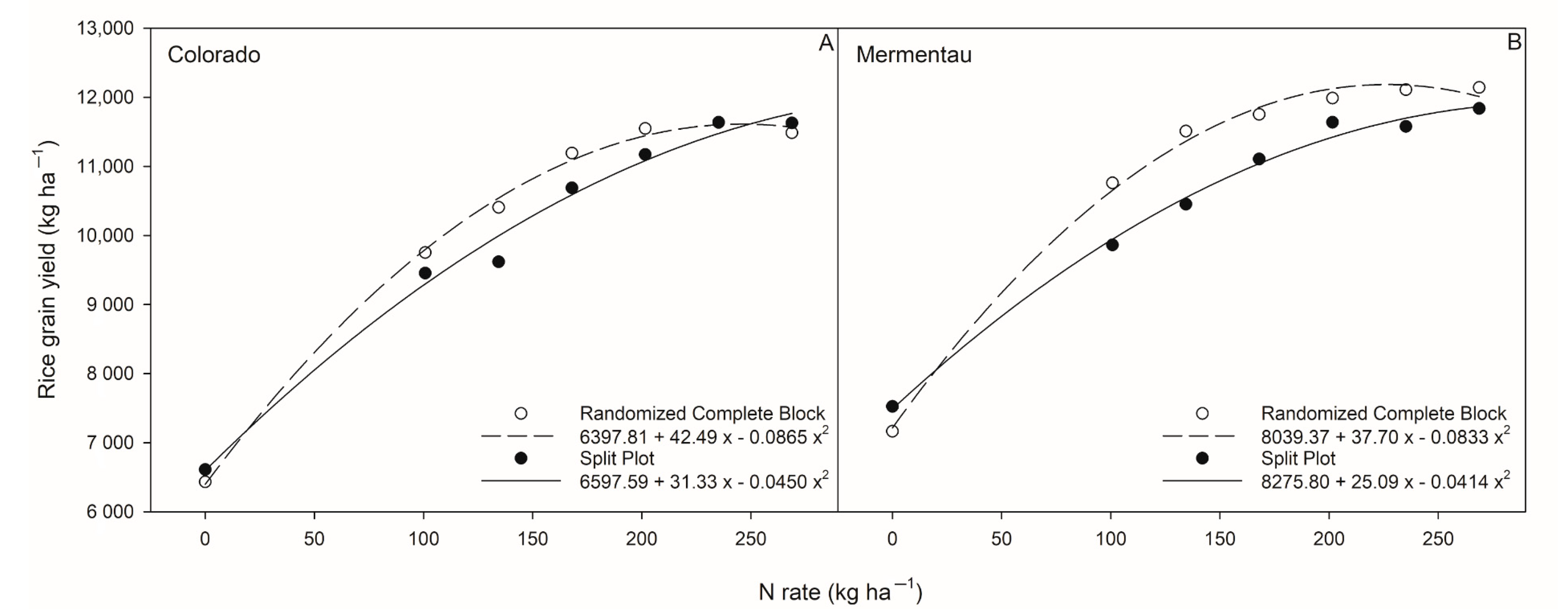Implications of Experimental Design on Predicting Economic Optimum Nitrogen Rates in Rice
Abstract
:1. Introduction
2. Materials and Methods
3. Results
4. Discussion
Author Contributions
Funding
Data Availability Statement
Conflicts of Interest
References
- USDA-ERS (U.S. Department of Agriculture, Economic Research Service) Rice Webpage. Available online: https://www.ers.usda.gov/topics/crops/rice/ (accessed on 29 October 2021).
- USDA-NASS (U.S. Department of Agriculture, National Agricultural Statistics Service) Quick Stats. Available online: https://quickstats.nass.usda.gov/ (accessed on 29 October 2021).
- Street, J.E.; Bollich, P.K. Rice Production. In Rice: Origin, History, Technology, and Production; Smith, C.W., Ed.; John Wiley & Sons: Hoboken, NJ, USA, 2003; pp. 271–296. [Google Scholar]
- Beuhring, N.; Kanter, D.; Walker, T.W.; Bond, J.; Silva, M.; Pringle, L.; Damicone, J.; Moore, B.; Fox, J.; Sciumbato, G.; et al. Mississippi Rice Growers Guide; Publication 2255; Mississippi State University Extension Service: Mississippi State, MS, USA, 2008. [Google Scholar]
- Saichuk, J.K.; Brown, S.; Deshotel, V.; Gauthier, S.; Growth, D.E.; Harrell, D.L.; Hollier, C.A.; Linscombe, S.D.; Oard, J.; Stout, M.J.; et al. Rice Varieties and Management Tips; LSU Agricultural Ctr. Publ. No. 2270; Louisiana State University Agricultural Center: Baton Rouge, LA, USA, 2014. [Google Scholar]
- Harrell, D.L.; Walker, T.W.; Salassi, M.E.; Bond, J.A.; Gerard, P.D. Modeling rice grain yield response to nitrogen fertilization for delayed-flood production. J. Plant. Nutr. 2011, 34, 2158–2171. [Google Scholar] [CrossRef]
- Gomez, K.A.; Gomez, A.A. Statistical Procedures for Agriculture Research, 2nd ed.; International Rice Research Institute; Wiley and Sons: New York, NY, USA, 1984. [Google Scholar]
- Gomez, K.A. Techniques for Field Experiments with Rice; Layout/Sampling/Sources of Error; International Rice Research Institute: Los Banos, Laguna, Philippines, 1972. [Google Scholar]
- Roberts, T.L.; Norman, R.J.; Slaton, N.A.; Hardke, J.T.; Greub, C.E.; Fulford, A.M.; Williamson, S.M.; Shafer, J.B.J.; Frizzell, D.L.; Duren, M.W. Field validation of the nitrogen soil test for rice (N-ST*R) for rice produced on clay soils. In B.R. Wells Arkansas Rice Research Studies 2013; Norman, R.J., Moldenhauer, K.A.K., Eds.; Arkansas Agricultural Experiment Station Research Series 617: Fayetteville, AR, USA, 2014; pp. 311–316. [Google Scholar]
- Norman, R.J.; Roberts, T.L.; Hardke, J.T.; Slaton, N.A.; Moldenhauer, K.A.K.; Frizzell, D.L.; Duren, M.W.; Castaneda-Gonzalez, E. Grain yield response of eight new rice cultivars to nitrogen fertilization. In B.R. Wells Arkansas Rice Research Studies 2013; Norman, R.J., Moldenhauer, K.A.K., Eds.; Arkansas Agricultural Experiment Station Research Series 617: Fayetteville, AR, USA, 2014; pp. 293–303. [Google Scholar]
- Norman, R.J.; Hardke, J.T.; Roberts, T.L.; Slaton, N.A.; Frizzell, D.L.; Duren, M.W.; Castaneda-Gonzalez, E. Response of two rice varieties to midseason nitrogen fertilizer application timing. In B.R. Wells Arkansas Rice Research Studies 2013; Norman, R.J., Moldenhauer, K.A.K., Eds.; Arkansas Agricultural Experiment Station Research Series 617: Fayetteville, AR, USA, 2014; pp. 303–310. [Google Scholar]
- Rogers, C.W.; Norman, R.J.; Brye, K.R.; Smartt, A.D.; Hardke, J.T.; Roberts, T.L.; Slaton, N.A.; Dempsey, R.; Fulford, A.M.; Frizzell, D.L. Rice grain yield as influenced by nitrogen source, rate, and application time. In B.R. Wells Arkansas Rice Research Studies 2013; Norman, R.J., Moldenhauer, K.A.K., Eds.; Arkansas Agricultural Experiment Station Research Series 617: Fayetteville, AR, USA, 2014; pp. 317–323. [Google Scholar]
- Slaton, N.A.; Fryer, M.; Roberts, T.L.; DeLong, R.E.; Dempsey, R.; Parvej, R.; Hedge, J.; Massey, C.G. Validation of soil-test-based fertilizer recommendations for flood-irrigated rice. In B.R. Wells Arkansas Rice Research Studies 2013; Norman, R.J., Moldenhauer, K.A.K., Eds.; Arkansas Agricultural Experiment Station Research Series 617: Fayetteville, AR, USA, 2014; pp. 324–331. [Google Scholar]
- Little, T.M.; Hills, F.J. Agricultural Experimentation, Design and Analysis; John Wiley and Sons: New York, NY, USA, 1978. [Google Scholar]
- Tabien, R.E.; Samonte, S.O.P.B.; Wilson, L.T.; Harper, C.H.; Medley, J.C.; Frank, P. Development and registration of ‘Colorado’, a high-yielding rice cultivar. J. Plant. Regist. 2015, 9, 60–66. [Google Scholar] [CrossRef]
- Oard, J.H.; Harrell, D.L.; Growth, D.E.; Bearb, K.F.; White, L.M., III; Linscombe, S.L. Registration of ‘Mermentau’ rice. J. Plant. Regist. 2014, 8, 135–138. [Google Scholar] [CrossRef]
- Blouin, D.C.; Webster, E.P.; Bond, J.A. On the analysis of combined experiments. Weed Tech. 2011, 25, 165–169. [Google Scholar] [CrossRef]
- Carmer, S.G.; Nyquist, W.E.; Walker, W.M. Least significant differences in combined analyses of experiments with two- or three-factor treatment designs. Agron. J. 1989, 81, 655–672. [Google Scholar] [CrossRef]
- SAS Institute. The SAS System for Windows Release 9.4; SAS Institute: Cary, NC, USA, 2013. [Google Scholar]
- Nelson, L.A.; Voss, R.D.; Pesek, J.T. Agronomic and statistical evaluation of fertilizer response. In Fertilizer Technology and Use; Engelstad, O.P., Ed.; American Society of Agronomy: Madison, WI, USA, 1985; pp. 53–90. [Google Scholar]
- MSU-DAE. Rice 2013 Planning Budgets, Budget Report No. 2012-06; Department of Agricultural Economics, Mississippi State University: Mississippi State, MS, USA, 2012. [Google Scholar]
- MSU-DAE. Rice 2014 Planning Budgets, Budget Report No. 2013-04; Department of Agricultural Economics, Mississippi State University: Mississippi State, MS, USA, 2013. [Google Scholar]


| Soil | ||||||
|---|---|---|---|---|---|---|
| Site | Year | Location | Series | Texture | Taxonomic Classification | Crop Rotation |
| 1 | 2013 | Shaw, MS | Sharkey | Clay | Very-fine, smectic, thermicChromic Epiaquerts | Rice-soybean |
| 2 | 2013 | Greenville, MS | Commerce | Sandy loam | Fine-silty, mixed, superactive, nonacid, thermic Fluvaquentic Endoaquepts | Rice-soybean |
| 3 | 2013 | Minter City, MS | Dubbs | Loam | Fine-silty, mixed, thermic TypicHapludalfs | Rice-soybean |
| 4 | 2014 | Shaw, MS | Sharkey | Clay | Very-fine, smectic, thermicChromic Epiaquerts | Rice-soybean |
| 5 | 2014 | Shaw, MS | Forestdale | Silty clayloam | Fine, smectitic, thermic TypicEndoaqualfs | Rice-soybean |
| 6 | 2014 | Arcola, MS | Sharkey | Clay | Very-fine, smectic, thermicChromic Epiaquerts | Rice-soybean |
| RCB | SP | Variability † | |||||||
|---|---|---|---|---|---|---|---|---|---|
| Soil | Env ‡ | CovParm § | Estimate | SE | Estimate | SE | RCB | SP | |
| Silt loam | 2 | rep | 4,387 | (15,578) | 204,806 | (197,326) | Block | ||
| Silt loam | 2 | rate × rep | 43,452 | (33,279) | 80,900 | (91,485) | MU err | 28.5% | 18.8% |
| Silt loam | 2 | Residual | 108,823 | (30,780) | 349,095 | (98,739) | SU err | 71.5% | 81.2% |
| Total (excluding block) | 152,274 | 429,995 | |||||||
| Silt loam | 3 | rep | 72,813 | (89,136) | 59,650 | (77,605) | Block | ||
| Silt loam | 3 | rate × rep | 0 | 115,956 | (79,752) | MU err | 0.0% | 32.6% | |
| Silt loam | 3 | Residual | 500,643 | (104,360) | 240,080 | (69,456) | SU err | 100.0% | 67.4% |
| Total (excluding block) | 500,643 | 356,036 | |||||||
| Silt loam | 5 | rep | 770,899 | (679,224) | 1,039,663 | (921,203) | Block | ||
| Silt loam | 5 | rate × rep | 0 | 0 | MU err | 0.0% | 0.0% | ||
| Silt loam | 5 | Residual | 852,109 | (175,777) | 1,237,312 | (255,238) | SU err | 100.0% | 100.0% |
| Total (excluding block) | 852,109 | 1,237,312 | |||||||
| Sharkey | 1 | rep | 17,263 | (24,768) | 42,255 | (49,267) | Block | ||
| Sharkey | 1 | rate × rep | 6,370 | (35,564) | 38,435 | (44,579) | MU err | 3.7% | 18.3% |
| Sharkey | 1 | Residual | 165,158 | (46,714) | 171,337 | (48,461) | SU err | 96.3% | 81.7% |
| Total (excluding block) | 171,528 | 209,772 | |||||||
| Sharkey | 4 | rep | 25,382 | (58,434) | 1,296,037 | (1,147,604) | Block | ||
| Sharkey | 4 | rate × rep | 111,307 | (109,078) | 630,452 | (232,871) | MU err | 21.9% | 70.5% |
| Sharkey | 4 | Residual | 397,462 | (112,419) | 263,833 | (74,623) | SU err | 78.1% | 29.5% |
| Total (excluding block) | 508,768 | 894,285 | |||||||
| Sharkey | 6 | rep | 66,962 | (69,678) | 233,282 | (207,379) | Block | ||
| Sharkey | 6 | rate × rep | 0 | 87,224 | (46,468) | MU err | 0.0% | 43.7% | |
| Sharkey | 6 | Residual | 255,516 | (52,709) | 112,270 | (32,253) | SU err | 100.0% | 56.3% |
| Total (excluding block) | 255,516 | 199,494 | |||||||
Publisher’s Note: MDPI stays neutral with regard to jurisdictional claims in published maps and institutional affiliations. |
© 2021 by the authors. Licensee MDPI, Basel, Switzerland. This article is an open access article distributed under the terms and conditions of the Creative Commons Attribution (CC BY) license (https://creativecommons.org/licenses/by/4.0/).
Share and Cite
Atwill, R.L.; Krutz, L.J.; Spencer, G.D.; Bond, J.A.; Reddy, K.R.; Gore, J.; Walker, T.W.; Boykin, D. Implications of Experimental Design on Predicting Economic Optimum Nitrogen Rates in Rice. Agronomy 2021, 11, 2296. https://doi.org/10.3390/agronomy11112296
Atwill RL, Krutz LJ, Spencer GD, Bond JA, Reddy KR, Gore J, Walker TW, Boykin D. Implications of Experimental Design on Predicting Economic Optimum Nitrogen Rates in Rice. Agronomy. 2021; 11(11):2296. https://doi.org/10.3390/agronomy11112296
Chicago/Turabian StyleAtwill, Richard Lee, Larry Jason Krutz, Gene Dave Spencer, Jason A. Bond, Kambham Raja Reddy, Jeffrey Gore, Timothy W. Walker, and Debbie Boykin. 2021. "Implications of Experimental Design on Predicting Economic Optimum Nitrogen Rates in Rice" Agronomy 11, no. 11: 2296. https://doi.org/10.3390/agronomy11112296
APA StyleAtwill, R. L., Krutz, L. J., Spencer, G. D., Bond, J. A., Reddy, K. R., Gore, J., Walker, T. W., & Boykin, D. (2021). Implications of Experimental Design on Predicting Economic Optimum Nitrogen Rates in Rice. Agronomy, 11(11), 2296. https://doi.org/10.3390/agronomy11112296






